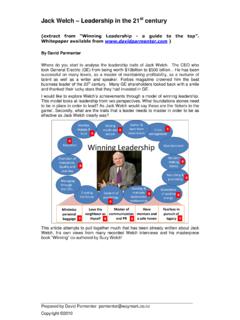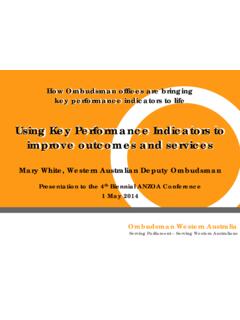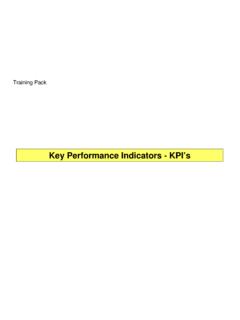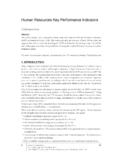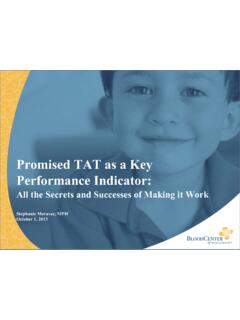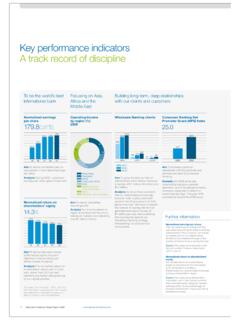Transcription of Implementing ‘winning’ KPIs in a Small-to-Medium Enterprise
1 Implementing winning kpis in a Small-to-Medium Enterprise By David Parmenter During workshops which I deliver I have been asked by attendees from Small-to-Medium enterprises (SMEs) about my advice on a simpler truncated process for Implementing winning kpis organisations with say less than 250 employees. Will winning kpis work for us? they ask. The answer is a profound yes . Finding your winning kpis will create much benefit . In many successful SMEs the success rests with the natural ability of a few key leaders and when they sell up or move on the organisation changes dramatically, often for the worse because the intuitive feel for the business that these individuals had has not permutated into the culture and operations of the organisation.
2 The key benefits of embedding winning kpis into the organisation include: The critical success factors (CSFs) of the organisation will be crystallized and conveyed to all staff There will be more empowerment and more clarity on what should be recorded and reported The SME will convey clearer, the strategy it is currently working on, to staff so they know which direction they should be travelling in All CEOs, both current and future, will be linked to staff who are working in the CSFs , there will be daily follow-up calls on the kpis Daily activities of the workforce will be linked to the strategic direction of the organisation, the el dorado of management.
3 As the two diagrams in Exhibit 1 show the change that winning kpis achieve can be very profound. Exhibit 1:The impact of winning kpis to the daily routine and tasks performed by staff Before wining kpis After implementation of winning kpis Changing thisTeam Team directiondirectionStrategic Strategic directiondirectionTo thisTeams in alignment with strategy The process is relatively simple and will take about six weeks of elapsed time. The eight phased process I recommend requires: An understanding of the four types of performance measures and what constitutes a winning KPI not all measures are kpis ! The laying of four foundation stones of the project and a commitment to ensure the project remains on these firm foundations The selling to the CEO, through their emotional drivers, that this project is the most important thing we can be doing at this point in time A balanced view of performance (the six perspectives of the balanced scorecard financial, internal process, customer focus, employee satisfaction, learning and growth, environment & community) Locating the five to eight success factors which have the greatest influence ( , the CSFs)
4 Out of the 30 or more success factors that the organisation has Finding measures that will drive the appropriate behaviour within the CSFs and SFs Working with past, current (yesterday and today s activity) and future (future scheduled dates to do key tasks) orientated measures The right timing to ensure resources will be freed up to complete this task. To assist the reader I have delivered a series of webcasts on and these are free to access. I would recommend that you first listen to four of my eleven KPI webcasts: Introduction to winning kpis (Aug 09) Finding your organization s critical success factors Implementing kpis in Smaller Orgs (<200 Staff) Reporting performance measures to improve performance The separation of performance measures out into four is very important for SMEs and larger organisations.
5 If we call all measures kpis we are not separating the wheat from the chaff . key result indicators (KRIs) both financial and non financial measures that give an overview on past performance and are ideal for the owner/Board as they communicate how management have done in a critical success factor or balanced scorecard perspective. See article on how to speed up Board reporting in issue xxxx. Typically these are measured monthly or quarterly. performance indicators (PIs) are non financial measures tell staff and management what to do. These are measured daily, weekly, or monthly and are not as important as the kpis .
6 Result indicators (RIs) are summary indicators, both financial and non financial that tell staff what they have done, these can be measured daily, weekly, monthly, or quarterly. key performance indicators ( kpis ) are non financial measures that tell staff and management what to do to increase performance dramatically. These are measured either 24/7, daily, or weekly. Exhibit 2 The four types of performance measures 4 types of performance measures4 types of performance measuresPIs&RIsKRIspeel to the coreto find the KPIsKPIspeel the skin tofind the PIsFor SMEs I recommend: 6-10 key result indicators (KRIs) reported monthly or quarterly to the owner/Board 30-50 performance indicators (PIs) and result indicators (RIs) daily, weekly or monthly 6-10 key performance indicators ( kpis ) 24/7, daily or weekly measures for the delivery in full on time to our key customers CSF for a manufacturing company A KRI could be the deliveries made on time in full to all customers by month going back 18 months A PI could be the on-time in-full deliveries this week A RI could be the number of returns we get from customers each week(the return will be a result of a number of things not happening)
7 A KPI could be the deliveries made yesterday to key clients that were late or incomplete Like a building, this project is only as good as its foundation stones, see Exhibit 3. The owner needs to realize that there needs to be consultation with management and staff, empowerment to fix important problems on the spot rather than seeking their permission. A radical change to what is measured, and how measures are reported, and lastly these measures should be linked to the CSFs of the organisation and consistent with the strategic direction the organisation is travelling on. Exhibit 3 The four types of performance measures The four foundation stonesThe four foundation stonesPIs and RIs PIs and RIs (80)(80)Measuring and Measuring and reporting only what reporting only what mattersmatters Resourcing In my book1 I talked much about the importance of in-house ownership.
8 In a SME it is likely that their will be a reliance on some outside professional advisor who knows the company well. This advisor must work closely with the in-house resources chosen to run the project. If the outside advisor drivers and implements this process there is a risk of lack of ownership. It is important that this project does not fail through lack of resourcing or the attention deficit disorder many organisation s suffer from. In SMEs many projects are simply added on to the existing workload and thus seldom have a chance to succeed. Within weeks management has moved on having lost interest partly due to the lack of rubber on the road . There will need to be some full time commitment, see Exhibit 4, and I would recommend the moving of the family photos to the project room otherwise the staff members will end up firefighting when they should be on the project!
9 Exhibit 4 a guide to the level of commitment the in-house resources will need tomake Size of SME (FTEs) 5-25 25-75 75-150 150-250 Duration 2 weeks 4 weeks 6 weeks 6 weeks External advisor Main driver Initiator and facilitator Facilitator Facilitator In house staff One person full time for 2 weeks One person full time for 2 weeks, part time for 2 weeks Two persons full time for 2 weeks, part time for 4 weeks Two persons full time for 3 weeks, part time for 3 weeks The eight phased approach The eight phased approach is discussed in detail in my book2 and the webcast3. The phases are set out in Exhibit 5 and discussed briefly in this article.
10 Exhibit 5 The eight phase process to implement in winning kpis in SMEs PhaseProject week pre123456post1 Selling the change and agreeing on the appropriate timing2 Workshop to find the organisations CSFs and start team scorecards3 KPI project team trained and empowered4 Teams complete their scorecards and record their measures5 Selecting organisational " winning kpis "6 Developing the reporting frameworks at all levels7 Facilitating the use of winning KPIs8 Refining kpis in 12 months to maintain their relevance Phase 1: Selling the change and agreeing on the appropriate timing. In this phase we ensure the senior management team4 (SMT) are sold in such a way as to ensure their commitment.


